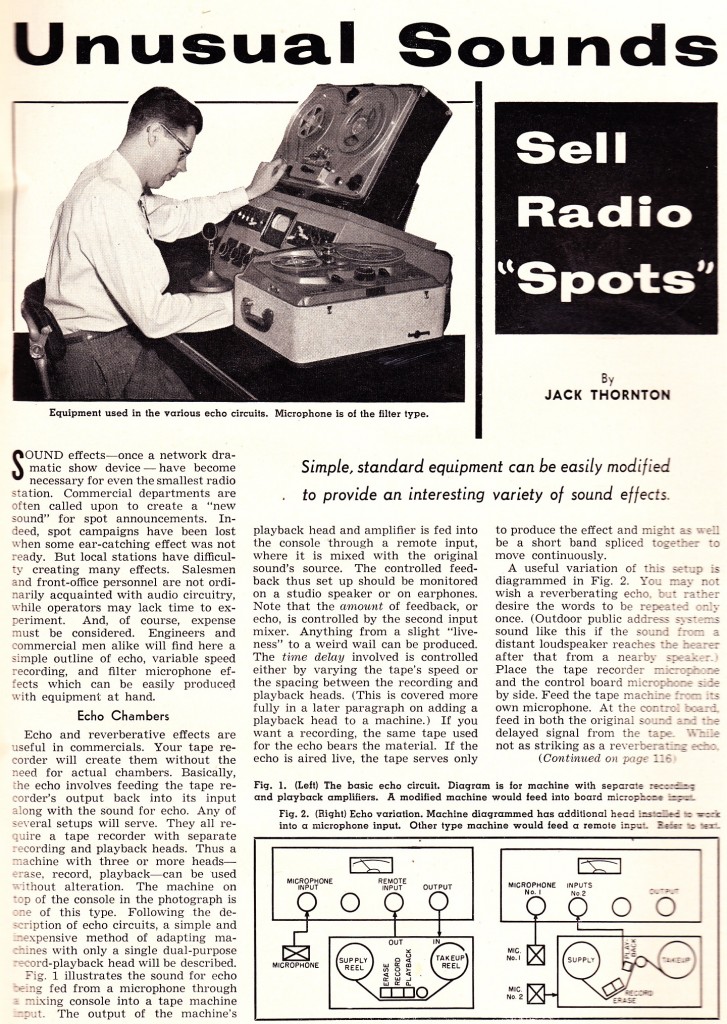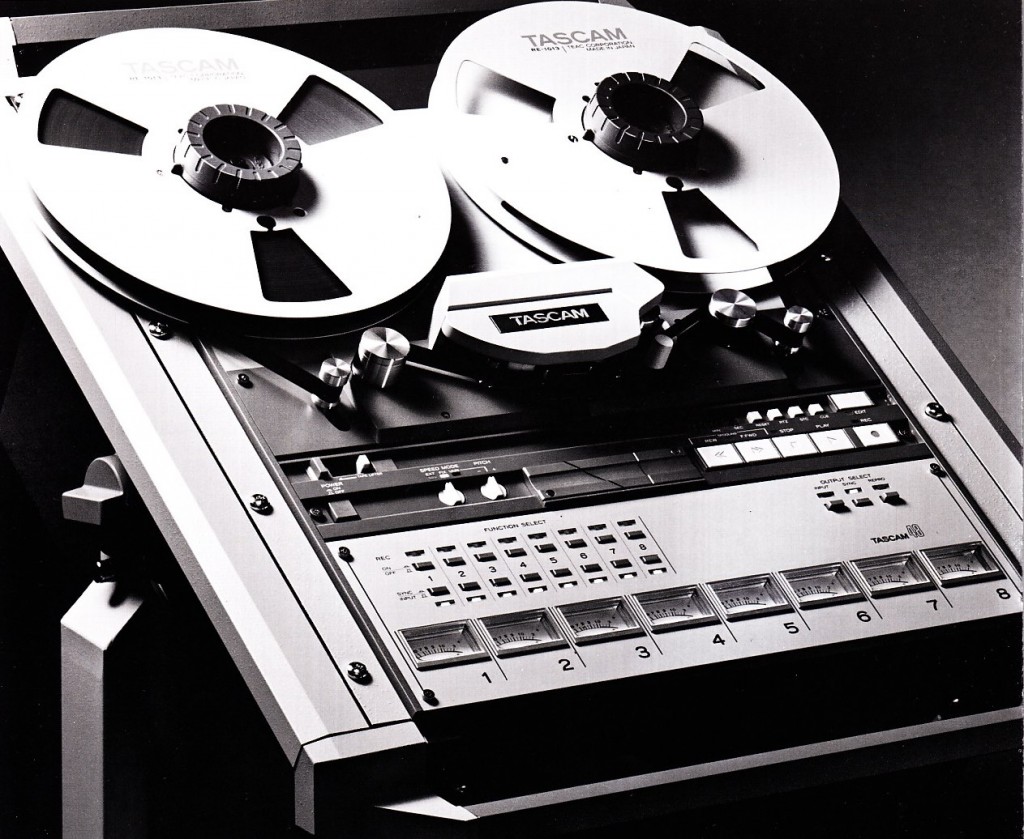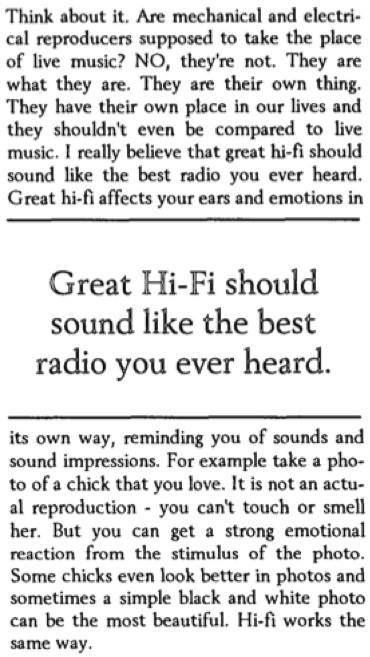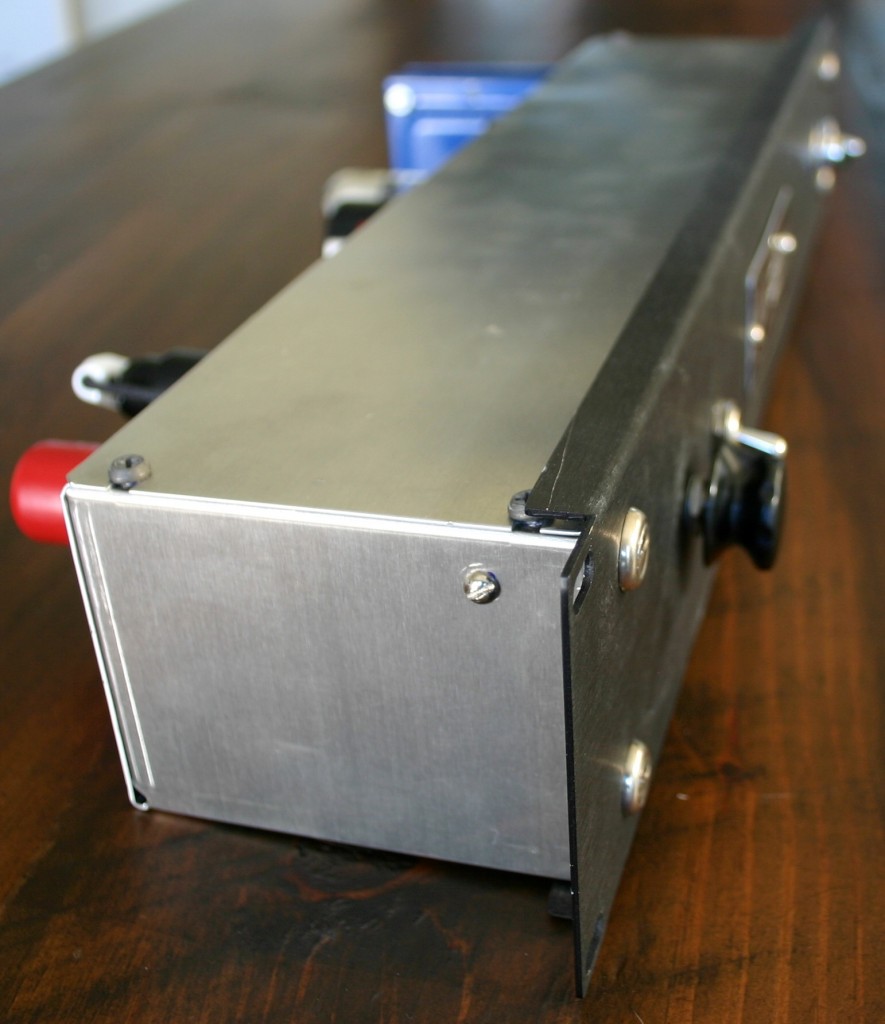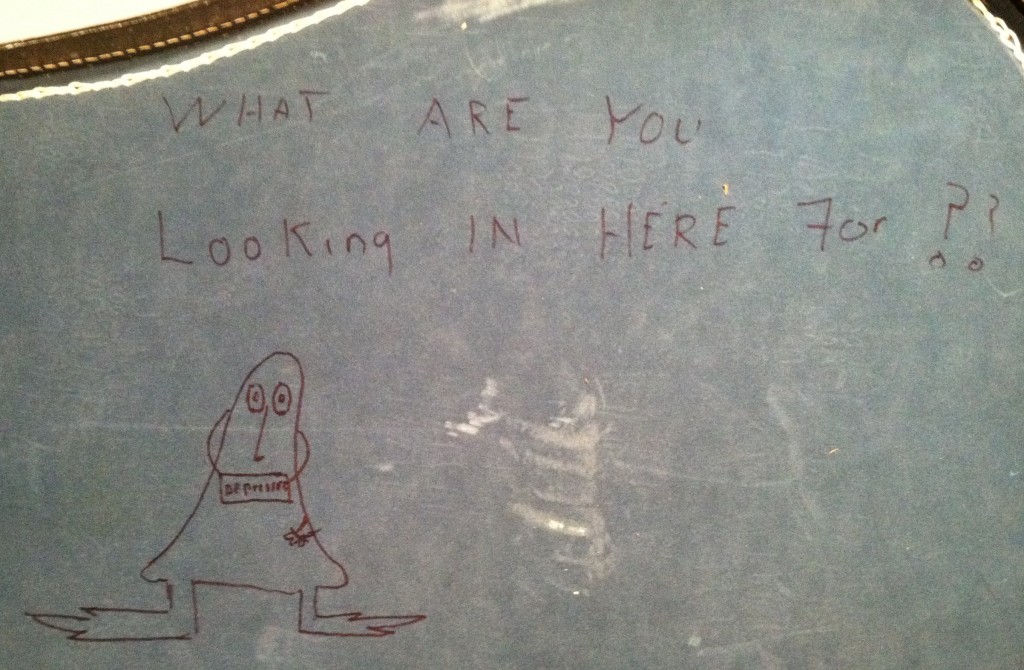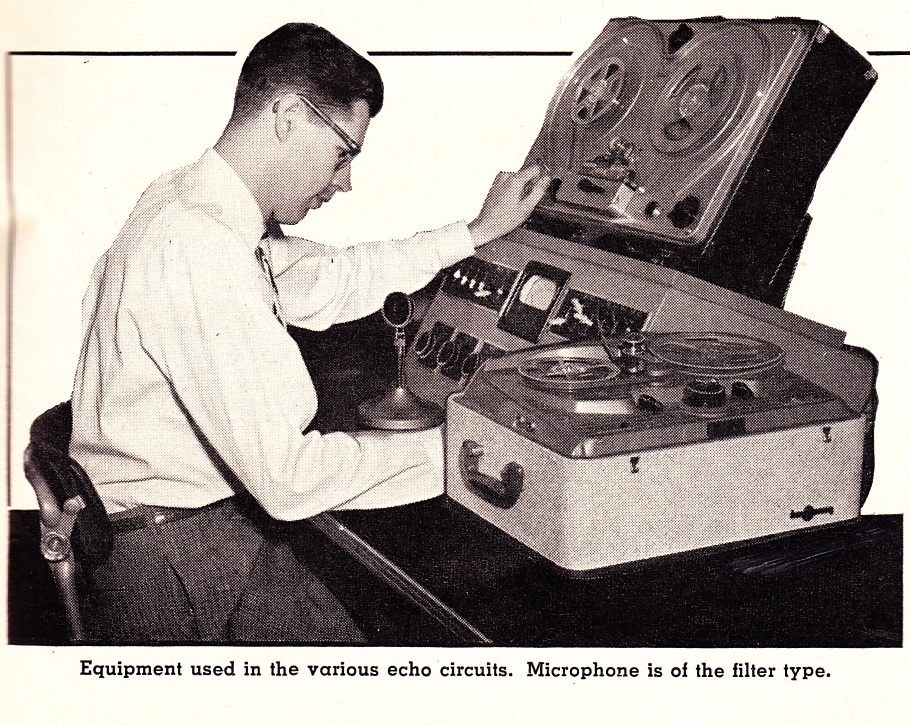 From Radio And Television News, 2/56: a short article concerning the creation of sound effects for use in radio commercials, AKA., radio ‘spots.’ The focus here is on creating special-effects (pitch shifting, echo, filter effects, etc) through direct physical manipulation of the tape-recorder (as opposed to utilizing additional outboard equipment).
From Radio And Television News, 2/56: a short article concerning the creation of sound effects for use in radio commercials, AKA., radio ‘spots.’ The focus here is on creating special-effects (pitch shifting, echo, filter effects, etc) through direct physical manipulation of the tape-recorder (as opposed to utilizing additional outboard equipment).
Category: Uncategorized
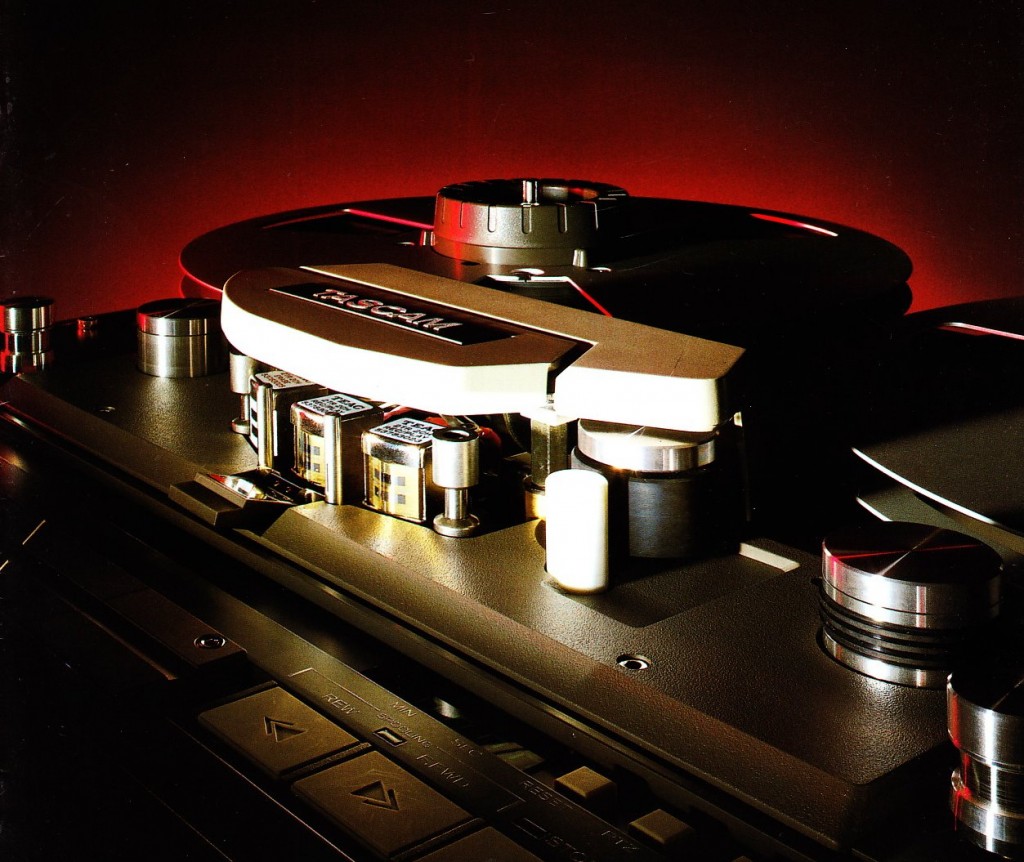 Download the complete twelve-page Tascam Series 40 catalog, c. 1984:
Download the complete twelve-page Tascam Series 40 catalog, c. 1984:
DOWNLOAD: Tascam40series1984
Products covered, with extensive text, specs, and photos, include: Tascam 42 1/4″ stereo tape machine, Tascam 44 four-track 1/4″ tape machine, and Tascam 48 1/2″ eight-track tape machine.
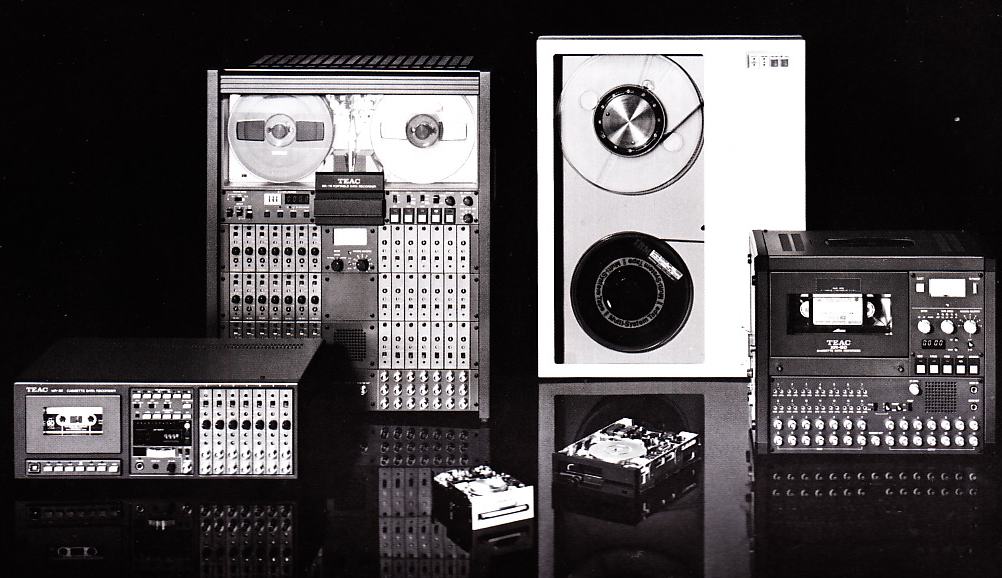 above: Tascam’s various data recorders of the early eighties. 21-track 1/2″ anyone?
above: Tascam’s various data recorders of the early eighties. 21-track 1/2″ anyone?
Tascam helped create the category of ‘home-recording-studio’ in the 1970s with their 4-track reel to reel machines. The 3440, Teac 3340, and Tascam 40-4 and 80-8 tape machines were the backbone of thousands of home studios and project studios. This line-up was improved in the 1980s with the introduction of the Series 40. The Tascam 42, 44, and 48 tape machines offered better performance than the older models, plus standard features such as balanced i/o, varispeed, and confidence monitoring (IE, they are all three-head decks). The battleship-grey finish of the series 40 lets you know that these are commercial/industrial machines, and the 70/80 lb weight reinforces that idea. (N.B. – Tascam also offered a series 50 with even better specs; i have no direct experience with these machines tho…)
The Tascam 48
Many years ago I inherited a couple dozen pro reel-to-reel machines from a media company that had updated to DAT. Otari 50/50s, Tascam 22s and 32s, Technics 1500s, etc… The best unit of the bunch was a Tascam 44. The operational characteristics and sonics of that machine were incredible. It is long gone now, like all the others, sacrificed to pay-the-rent in late 90’s Williamsburg. It’s one of the few studio pieces that I really regret selling. I don’t think I would ever go back to analog tape as a working production format, but as an effect of sorts analog tape has a quality that nothing else can deliver. Just yesterday I was in the studio with E’s Marantz dual-cassette deck, bouncing some submixes onto a Type 1 Sony cassette and then back into Pro Tools, trying to get just the right amount of high and low end breakup. I got it right after about ten attempts with different level settings. A three-head machine would have been very useful in that situation… especially one with varispeed.
Anyone still using a Tascam 44 or 48 for music production? Drop a line and let us know…
The Williamson Amp, part one
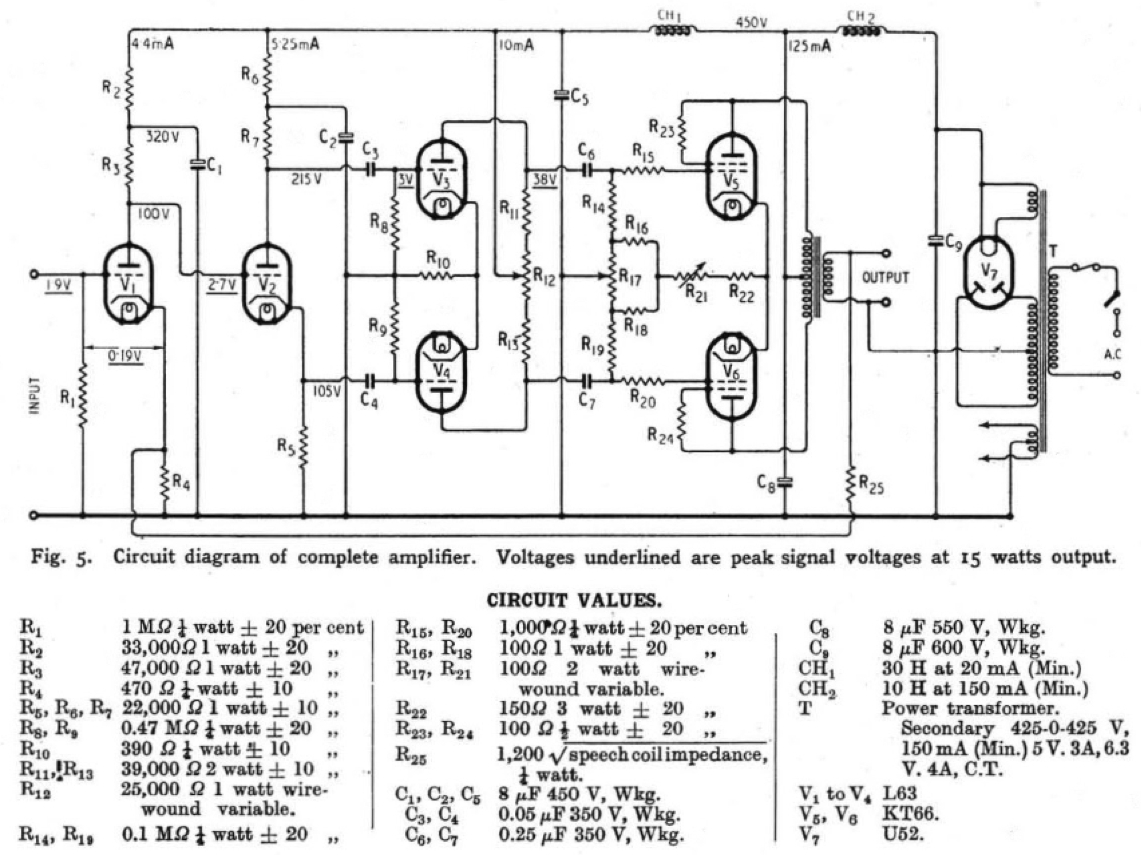 The original Williamson hi-fi amplifier schematic as published in “Wireless World” magazine (UK) May 1947.
The original Williamson hi-fi amplifier schematic as published in “Wireless World” magazine (UK) May 1947.
The Williamson amplifier is considered one of the earliest hi-fidelity audio amplifier designs. It is certainly one of the most popular audio circuits ever developed for DIY’rs. Without fail I seem to turn up at least one home-brewed Williamson every year at the local estates+fleas. A PS Dot Com reader from the UK sent us the original articles from “Wireless World” as published in 1947. I have yet to build a pair of these myself, and the idea of starting ‘from the top,’ as it were, with the original design, is appealing. A few things to note: check out the provision to balance the driver stage, and separate bias level and balance controls for the output stage. Also: check out R25: the formula for determining the feedback loop resistor. I wish every schematic included this notation. NB: the ‘L63’ valve is simply a 6J5 – aka, one half of a 6SN7. the ‘U52’ rectifier is a 5U4 or equivalent. ‘KT66’ is a better-performing 6L6; feel free to use 6L6 or 5881 if necessary.
Christmas 2011
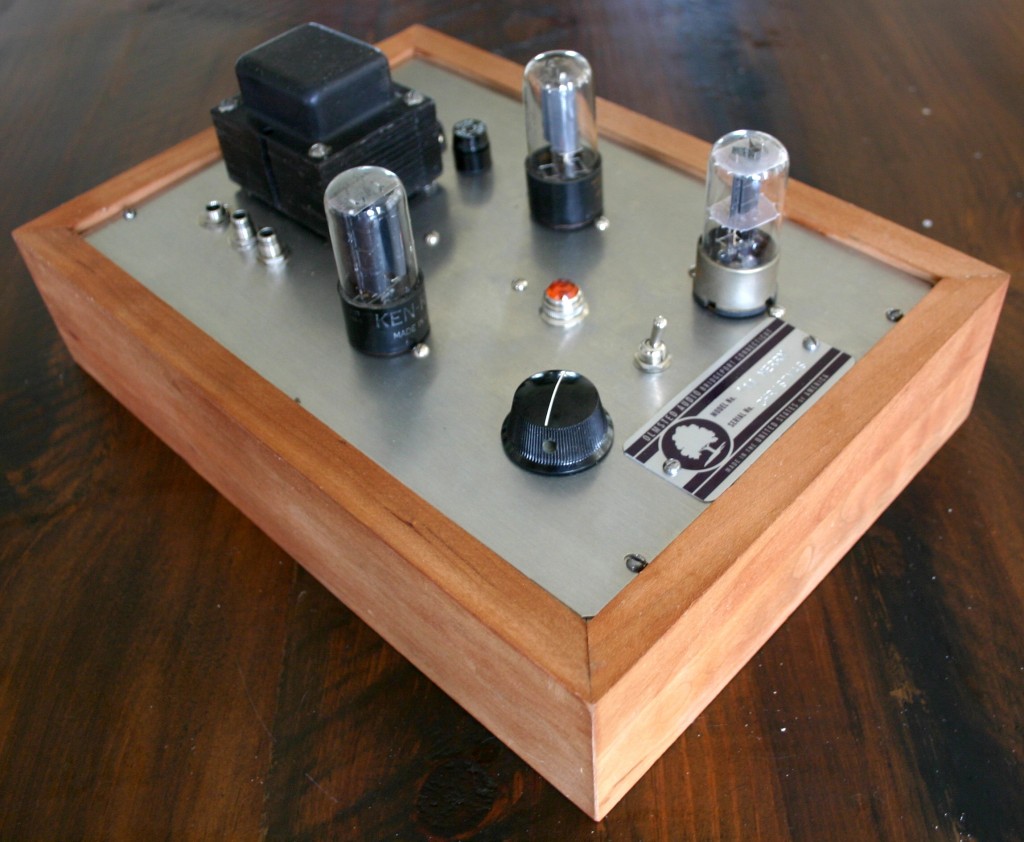 Despite the hectic nature of the holiday-season, I am inevitably able to produce one piece each year as a gift for some person or persons near+dear to me. This year’s recipient of the prize-winning entry in Connecticut’s Got Free Time! will receive this charming set.
Despite the hectic nature of the holiday-season, I am inevitably able to produce one piece each year as a gift for some person or persons near+dear to me. This year’s recipient of the prize-winning entry in Connecticut’s Got Free Time! will receive this charming set.
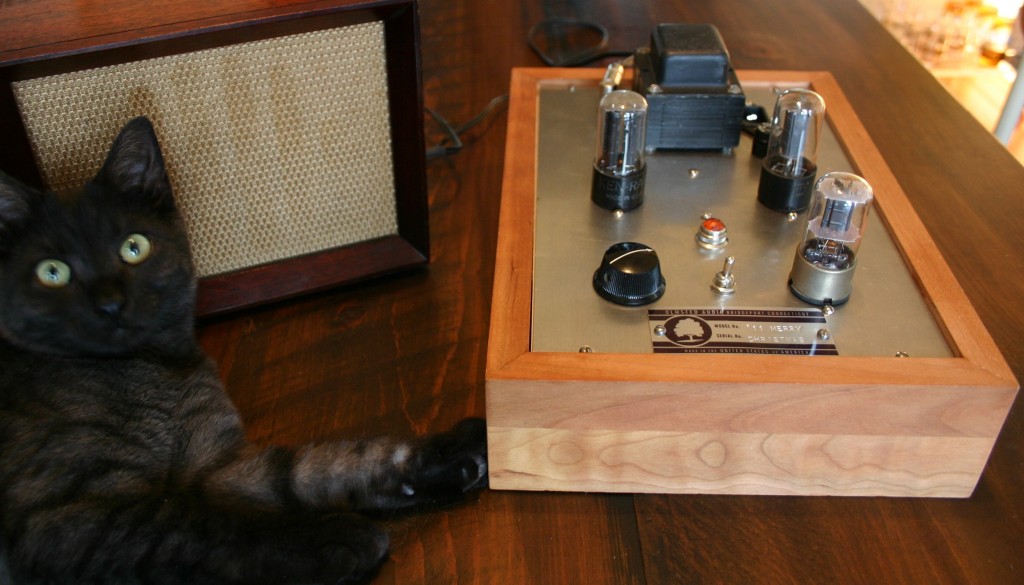 I’d been thinking a bit about V. Gallo’s comment in Sound Practices #1… see the previous post for the full details… basically, the idea that ‘good hi-fi should sound like the best radio you’ve ever heard’ (as opposed to some supposed verisimilitude to an actual acoustic event). Well, here’s an attempt at the best-sounding radio you’ve ever heard. At the front end, two RCA inputs mix via fixed resistors to a single 100K pot, and then onto the grid of the voltage amplifer stage (6J5, the ‘single’ triode iteration of the more common 6SN7); this feeds one 6V6 via a gigantic paper coupling cap; in the power supply, a 5Y3 rectifier and R/C filtering with large (50uf) caps and an extra filtering stage before the output transformer for a n extremely quiet, stable signal. The circuit is very similar to what you would find on the back-end of most transformer-mains-isolated AM/FM tube radios of the 40s and 50s.
I’d been thinking a bit about V. Gallo’s comment in Sound Practices #1… see the previous post for the full details… basically, the idea that ‘good hi-fi should sound like the best radio you’ve ever heard’ (as opposed to some supposed verisimilitude to an actual acoustic event). Well, here’s an attempt at the best-sounding radio you’ve ever heard. At the front end, two RCA inputs mix via fixed resistors to a single 100K pot, and then onto the grid of the voltage amplifer stage (6J5, the ‘single’ triode iteration of the more common 6SN7); this feeds one 6V6 via a gigantic paper coupling cap; in the power supply, a 5Y3 rectifier and R/C filtering with large (50uf) caps and an extra filtering stage before the output transformer for a n extremely quiet, stable signal. The circuit is very similar to what you would find on the back-end of most transformer-mains-isolated AM/FM tube radios of the 40s and 50s.
The speaker is a 1950’s extension speaker, maker unknown; it has extremely nice finish work and detail; it is unusual in that both the front and back of the enclosure are open via grille clothe, creating a ‘bright’ and ‘dull’ side; position the speaker as-you-like for a very unconventional tone control!
The cabinet is 1×3 solid cherry with internal bracing. Keeping with the ‘best-radio’ theme, the tubes, transformers, and brown Bakelite sockets are pulls from various Ancient Radios that have wandered into the shop over the years. And yea it sounds great…
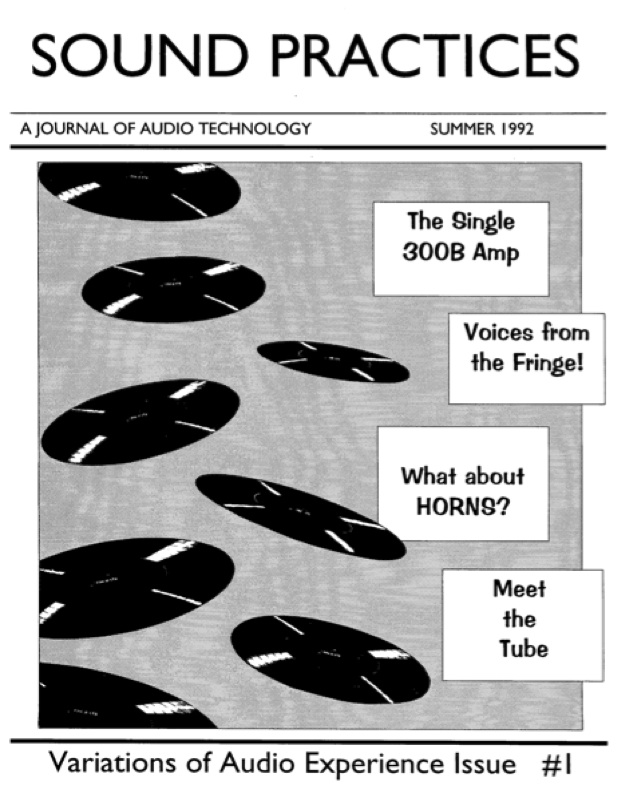 I was checking out this bro’s blog (or bros’ blog? lots of chick pics) recently and I came across an endorsement of the PDF version of Sound Practices magazine. I had never seen an actual issue of Sound Practices (it ceased publication a couple of years before I built my first tube amp), but I had read a few articles that had been put online, and I had encountered much discussion of it in various online chat groups. Seemed worth taking a look at. I purchased a $30 (delivered) CDR containing all sixteen issues as a giant PDF from eBay seller n5Kat. Not cheap, but all this scanning does take some time, plus the PDF has some useful navigation features built in.
I was checking out this bro’s blog (or bros’ blog? lots of chick pics) recently and I came across an endorsement of the PDF version of Sound Practices magazine. I had never seen an actual issue of Sound Practices (it ceased publication a couple of years before I built my first tube amp), but I had read a few articles that had been put online, and I had encountered much discussion of it in various online chat groups. Seemed worth taking a look at. I purchased a $30 (delivered) CDR containing all sixteen issues as a giant PDF from eBay seller n5Kat. Not cheap, but all this scanning does take some time, plus the PDF has some useful navigation features built in.
Anyhow… it arrived and $30 well spent. You can see a list of some of the various articles contained within at this link. Sound Practices is aimed squarely at enthusiasts of vintage hi-fi, experiementers, and hobbyist builders, rather than the much more electrical-engineering-oriented Audio Amateur/Audio Electronics, another publication from the same period which frankly tends to confuse me half the time. Let’s put it this way,,, there’s not a lot of math in Sound Practices.
So what’s the point. If you’ve read this far in this post, you are likely one of my regular readers, and if you managed to make it back several times to this fairly niche website, I am pretty sure you would dig Sound Practices. Still available for $30, world-wide shipping included, on eBay.
On a closing note… an unexpected bonus for me was discovering that one of my favorite writers on the subject of vintage audio-gear was a regular contributor. I refer to one Vincent Gallo. I’ll end with a bit from his first piece in the zine, surprisingly free from the (albeit hilarious) hostility that usually marks his writing: what follows truly gets to the heart of why-antique-audio-equipment-matters, as well as a fundamental relationship between sound on the one hand and audio on the other:
The BRDCSTR
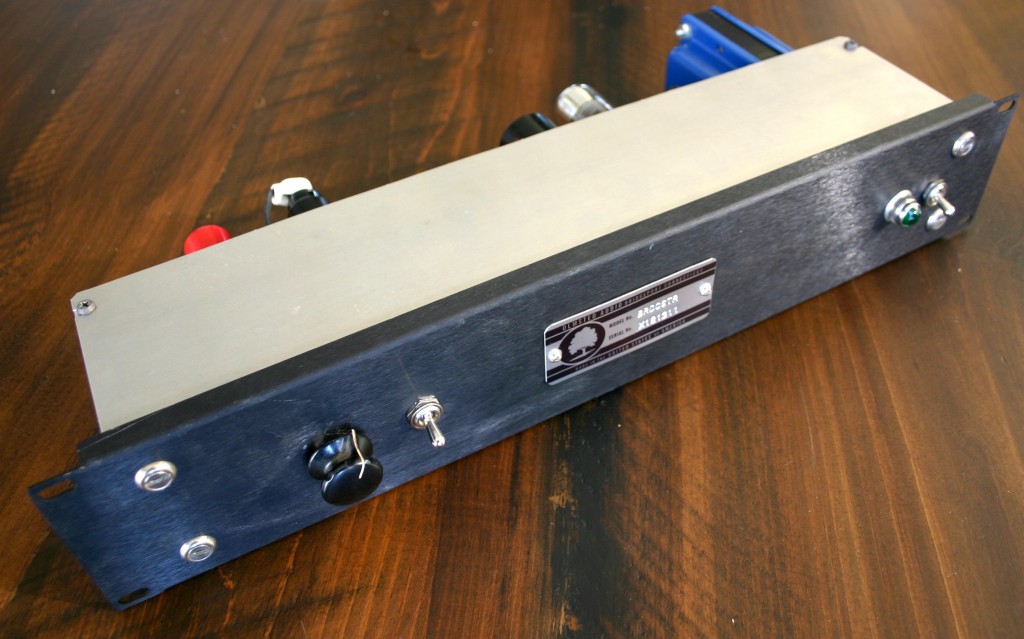 Above: The BRDCSTR, a two-stage vacuum-tube microphone preamp inspired by classic 1940s broadcast audio preamps. Single-ended design with a 6SJ7 and 6J7 tubes, massive output transformer, and only one capacitor in the signal path. I have built more of these than any other design; people really seem to respond to the sound. It’s pretty much the least ‘stuff’ that you can put between a microphone and your A/D convertor. All the attitude of ancient tube studio equipment without the hum and the noise, and with much better frequency response.
Above: The BRDCSTR, a two-stage vacuum-tube microphone preamp inspired by classic 1940s broadcast audio preamps. Single-ended design with a 6SJ7 and 6J7 tubes, massive output transformer, and only one capacitor in the signal path. I have built more of these than any other design; people really seem to respond to the sound. It’s pretty much the least ‘stuff’ that you can put between a microphone and your A/D convertor. All the attitude of ancient tube studio equipment without the hum and the noise, and with much better frequency response.
Astatic Microphones 1964
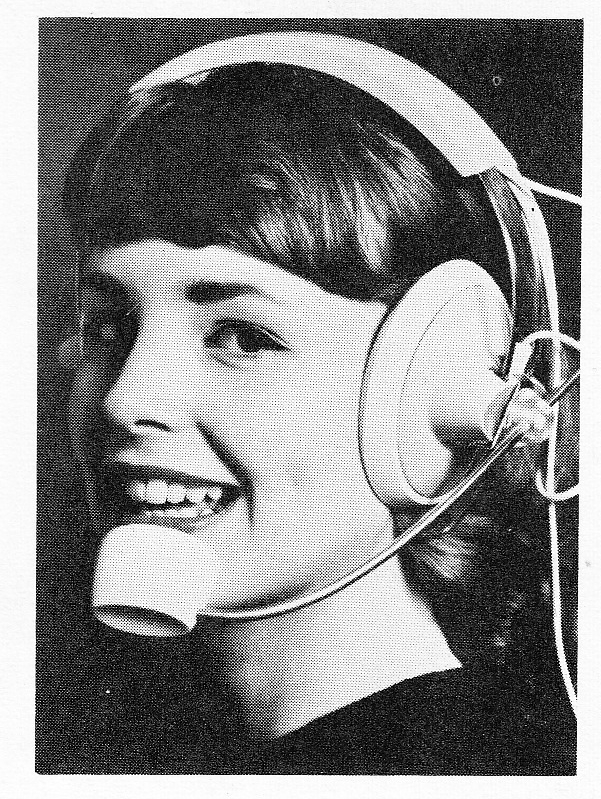 Download the complete eight-page 1964 ASTATIC microphone and phono cartridge catalog:
Download the complete eight-page 1964 ASTATIC microphone and phono cartridge catalog:
DOWNLOAD: Astatic_1964_catalog
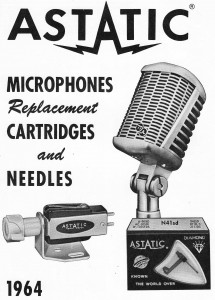 Models covered, with text, specs, and photos, include: hundreds of phonograph cartridges and needles; Astatic microphones model 332, 22, 225H, 335L, 77, 77-L, 788 ‘Metro’, 888 ‘Tempo,’ 988 ‘Vogue,’ Astatic 331,DN-50, UG8-DN50, JT-30, D-104, 513H, 511, 531, 150, 151, 10M5A, L-1, T-3, and 551 microphones.
Models covered, with text, specs, and photos, include: hundreds of phonograph cartridges and needles; Astatic microphones model 332, 22, 225H, 335L, 77, 77-L, 788 ‘Metro’, 888 ‘Tempo,’ 988 ‘Vogue,’ Astatic 331,DN-50, UG8-DN50, JT-30, D-104, 513H, 511, 531, 150, 151, 10M5A, L-1, T-3, and 551 microphones.
Astatic was mostly known for communications mics, aka., voice frequency mics, aka, mics that were intended to accentuate the 300hz-3000hz frequency band.
See this previous post for earlier ASTATIC mic coverage.
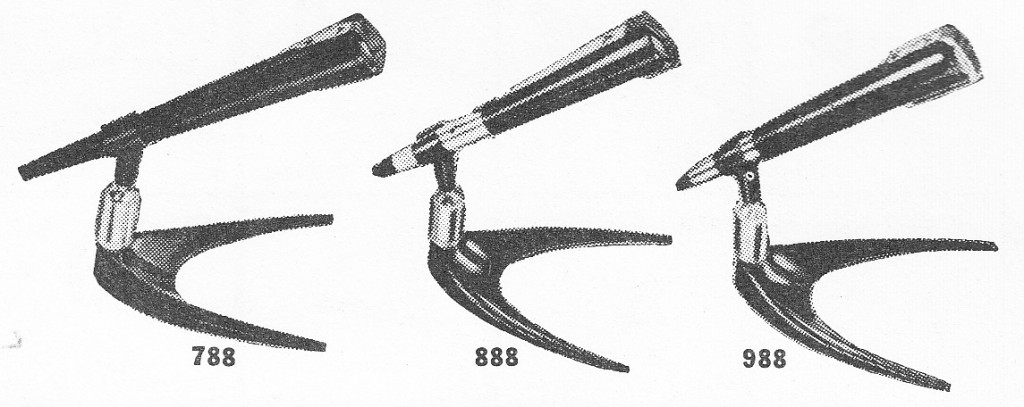 Above, the ASTATIC 788, 888, and 988 studio mics, aka the “Metro,” Tempo,” and “Vogue.” The 988 was the top-of-the-line and boasted impressive specs. I have never come across one of these. Anyone?
Above, the ASTATIC 788, 888, and 988 studio mics, aka the “Metro,” Tempo,” and “Vogue.” The 988 was the top-of-the-line and boasted impressive specs. I have never come across one of these. Anyone?
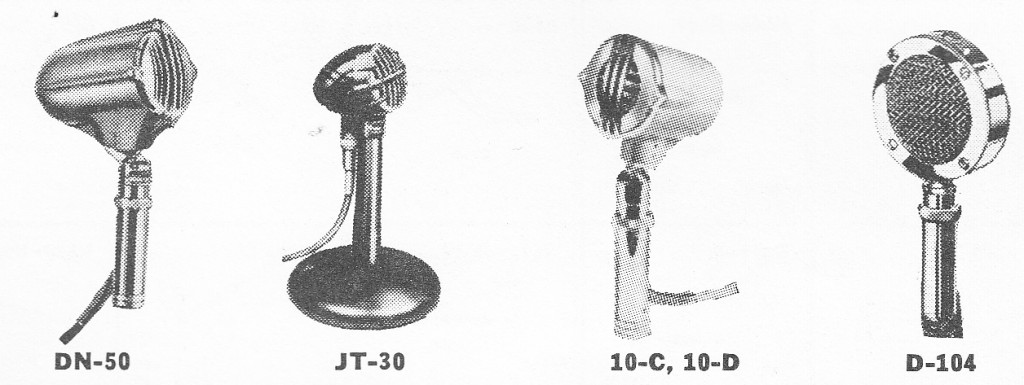 Above, the various ‘heads’ that were available to mount on the ASTATIC ‘squeeze-to-talk’ base unit. See here for details.
Above, the various ‘heads’ that were available to mount on the ASTATIC ‘squeeze-to-talk’ base unit. See here for details.
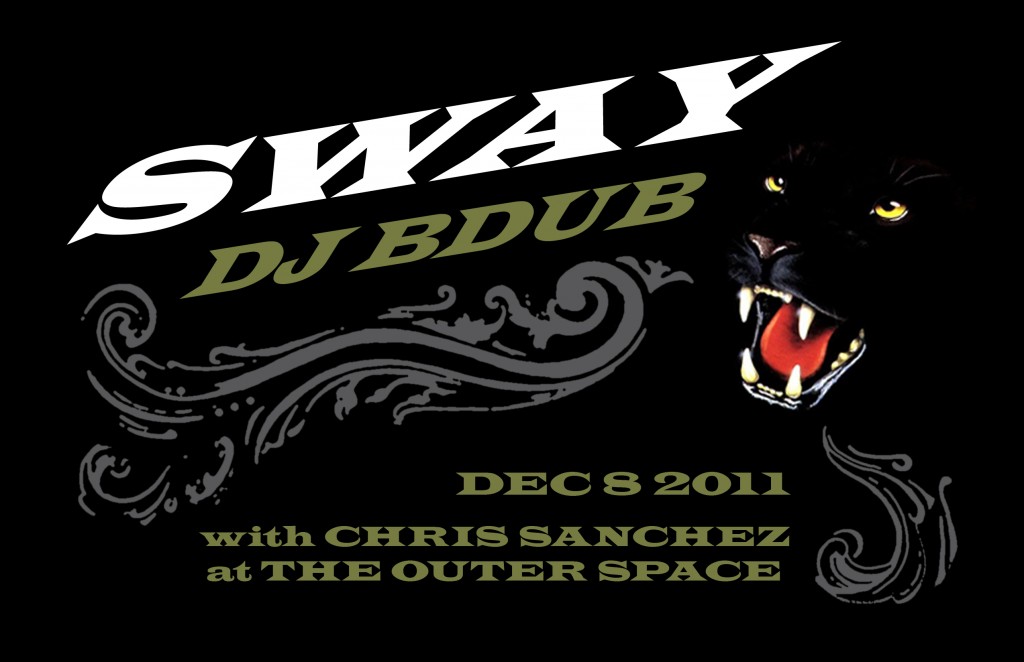 This Thursday 12.8.11 I’ll be doing a live set at The Outer Space in Hamden CT. The Outer Space is the 21+ venue operated in conjunction with Hamden’s legendary “The Space.”
This Thursday 12.8.11 I’ll be doing a live set at The Outer Space in Hamden CT. The Outer Space is the 21+ venue operated in conjunction with Hamden’s legendary “The Space.”
I’m appearing as part of BDUB’s Sway night. I’ll be on around 830. This will be strictly a vinyl-only affair… no surprises there. Have a beer or four as i dig into the best of 2o years spent searching for the secret gems of Nixon-Era rocknroll… for a preview you can check out my two recent appearances on WPKN FM. Listen here and here… and check this link for some recent mixtapes...
The Outer Space: 295 Treadwell Street, Hamden CT: Thurs Dec 8 2011
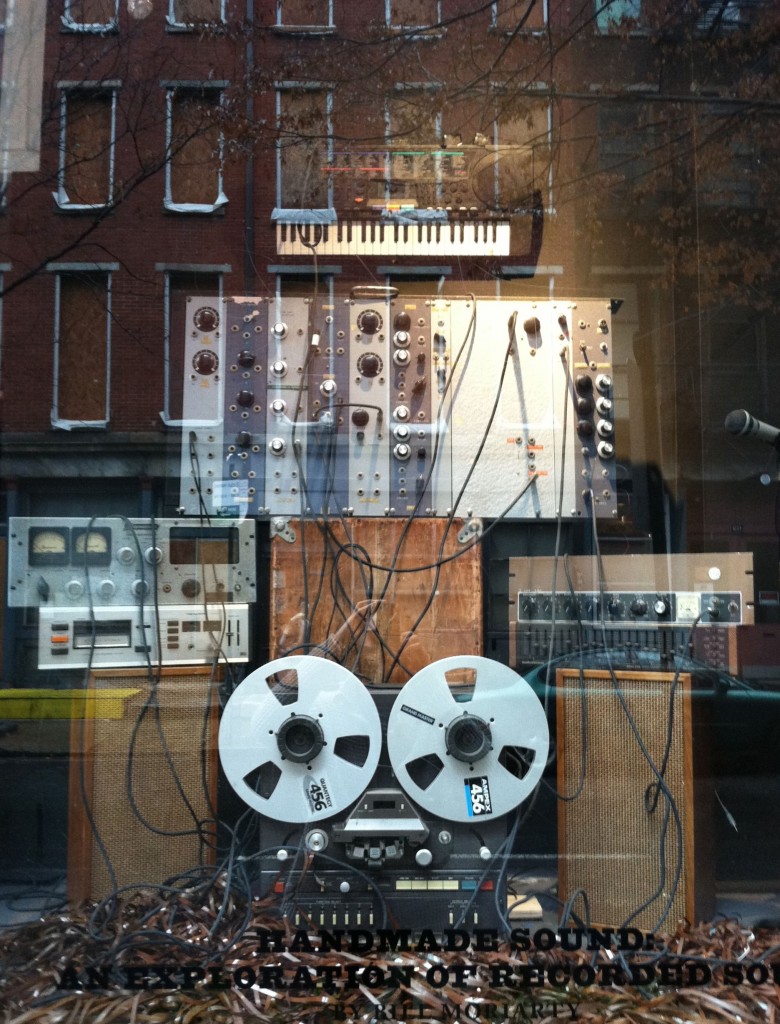 Walking around Philadelphia I noticed this shop-window. Wow these people really had my number. The shop is called Art In The Age Of Mechanical Reproduction (h.f. AITAOMR), which is a reference to a seminal essay by Walter Benjamin. Benjamin was interested in understanding how our concept of value in art was altered by the new processes of mechanical reproduction (offset printing, phonograph records, etc) which became widely available in the early 20th century. ANYways… AITAOMR is a fine shop with appealling apparel and lifestyle items offered for sale. They also market their own line of rustic flavored boozes you can sample in the shop (sold elsewhere at licensed agents).
Walking around Philadelphia I noticed this shop-window. Wow these people really had my number. The shop is called Art In The Age Of Mechanical Reproduction (h.f. AITAOMR), which is a reference to a seminal essay by Walter Benjamin. Benjamin was interested in understanding how our concept of value in art was altered by the new processes of mechanical reproduction (offset printing, phonograph records, etc) which became widely available in the early 20th century. ANYways… AITAOMR is a fine shop with appealling apparel and lifestyle items offered for sale. They also market their own line of rustic flavored boozes you can sample in the shop (sold elsewhere at licensed agents).
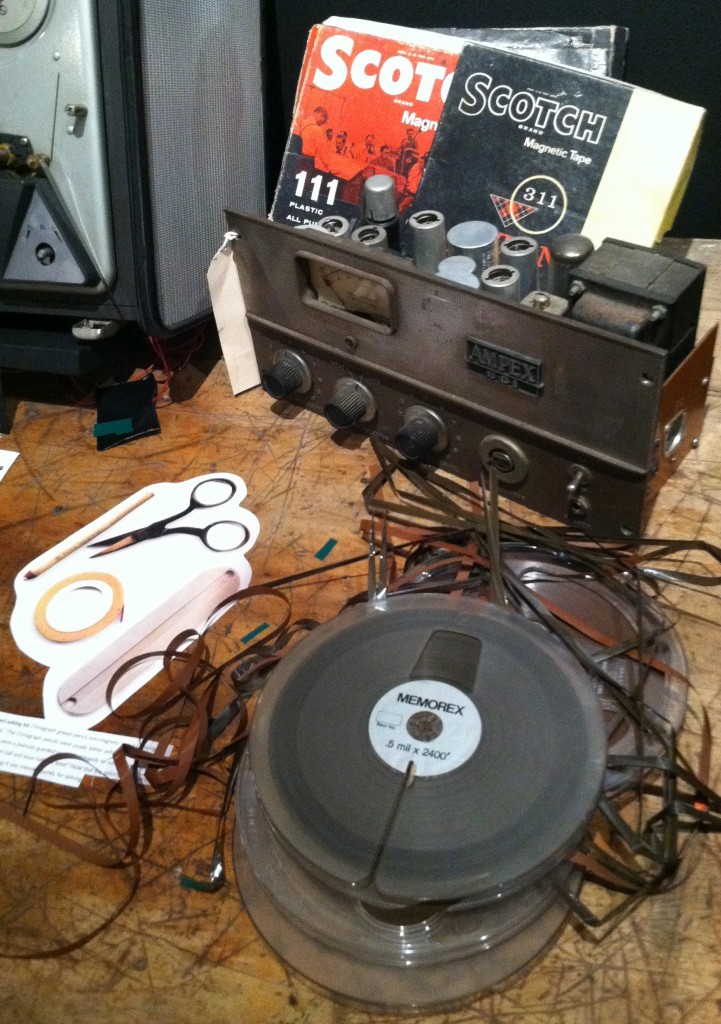 Turns out that the shop-window display is part of an in-store exhibit of audio-technology that was put together by record producer/engineer Bill Moriarty, who has worked with popular artists like Man Man and Dr. Dog. It’s a fun tactile display that foregrounds some of the crucial basic processes we use in audio work: editing, mixing, reverberation, ‘effects processing,’ etc.
Turns out that the shop-window display is part of an in-store exhibit of audio-technology that was put together by record producer/engineer Bill Moriarty, who has worked with popular artists like Man Man and Dr. Dog. It’s a fun tactile display that foregrounds some of the crucial basic processes we use in audio work: editing, mixing, reverberation, ‘effects processing,’ etc.
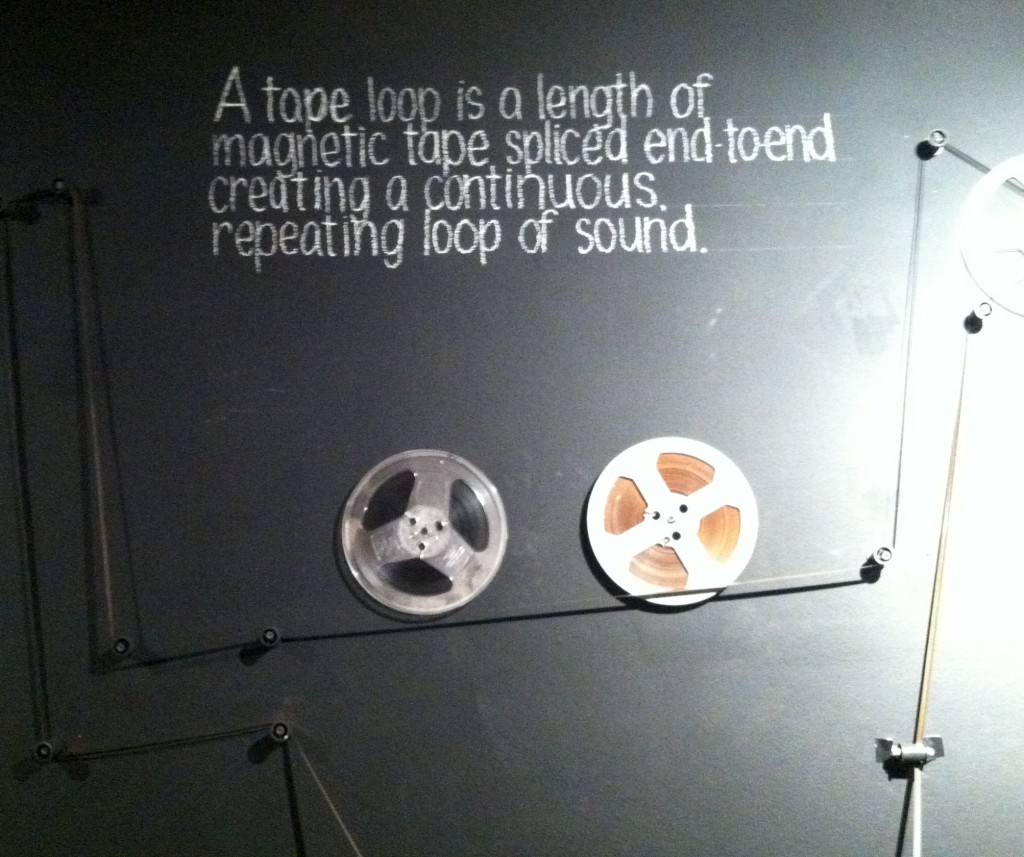 The exhibit is up for a few more days; you can read more about it in Moriarty’s own words at his blog.
The exhibit is up for a few more days; you can read more about it in Moriarty’s own words at his blog.
I purchased a chromed-the-fukk-out sixties no-name hollowbody for a few bucks at the flea mkt last weekend. Nothing special, but marker’d inside the case was this piece of folk art. Too bad it didn’t have a four-track demo of this kid’s music in there too.
Kinda reminds of the best haiku I ever heard: “Fifteen.” Credit for this one goes to K.M.:
sitting in my room
metallica really rules
I am so angry
See here for more ‘exclusive bonus content.’
UPDATE:
SEE HERE for a film-version of ‘found in an old guitar case’
